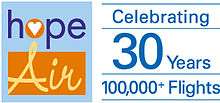Hope Air

Hope Air is a national charity that arranges free non-emergency medical flights for low-income Canadians who must travel far from home to access healthcare. Since its inception in 1986, the charity has arranged over 100,000 flights.[1] Since 2011, the charity's patron has been Canadian Governor General David Johnston.[2] Also in 2011, Canadian comedian Rick Mercer became the charity's honorary patron [3] Airlines donating seats include Bearskin Airlines, WestJet, Central Mountain Air, Pacific Coastal Airlines, Porter Airlines, Hawkair, and Delta Air Lines.[4]
History
.jpg)
Hope Air was founded in 1986 by Joan Rogers and Jinnie Bradshaw under the name Mission Air Transportation Network. In the early years, corporations signed up with Mission Air to use their planes. However, soon after launching Mission Air attracted commercial airlines, with over 90 per cent of flights taking place through airline partners currently.
By 1993 the organization had provided over 10,000 flights.[5]
In 1995, Romeo Leblanc, then-Governor General of Canada, became Hope Air’s first Viceregal patron. Every Governor General of Canada since has been the charity’s patron.
In 1996, WestJet was founded and immediately donated its first flights to Hope Air. Its donations increased and WestJet is Hope Air’s largest airline partner.
In 1999, Mission Air changed its name to Hope Air. Also in 1999, Hope Air began to partner with private pilots who began flying Hope Air clients on their aircraft, as part of the charity’s Volunteer Pilot Program.
In 2001, Marc Garneau became a National Honorary Patron of Hope Air. He served in this role until 2015, when he resigned after being appointed Minister of Transport.
In 2006, the charity celebrated its 20th anniversary and arranged its 50,000th flight.
In 2010, British Columbia struck a partnership with Hope Air to provide flights to residents of the province who need to travel for healthcare. The province solidified its partnership with the charity by investing $1.5 million in 2015.[6]
That same year, the organization arranged over 10,000 flights, the most ever in a single calendar year. On December 3, 2015 Hope Air celebrated its 100,000th flight.[7]
How Hope Air operates
Hope Air provides flights under four main flight programs: Commercial Airline Donation Program, Flight Purchase Program, Volunteer Pilot Program and the Business Aviation Registry. The charity has a mixed donor base made up of individuals, foundations and corporations. A number of Canadian airlines provide in-kind donations of seats on scheduled flights.
The Commercial Airline Donation Program is based on partnerships with various Canadian airlines that donate seats on flights to Hope Air clients. In these cases the charity covers the cost of taxes and regular fees associated with airline tickets, while commercial airlines provide flight tickets.
The Flight Purchase Program entails Hope Air purchasing seats on commercial flights for Hope Air clients.
The Volunteer Pilot Program partners with private pilots who use their aircraft to fly Hope Air clients to medical appointments.[8]
The Business Aviation Program is the newest flight program under which Hope Air operates. Through this program, corporate aircraft owners and operators in Canada provide public benefit flights to clients. The Business Aviation Program was launched in mid-2014 after the Canadian Transportation Agency determined that Hope Air was not an "air service" and subsequently removed restrictions which previously limited the charity's ability to provide flights on private aircraft [9]
Hope Air's impact
About 20 per cent of Hope Air Clients say that they wouldn’t go to their appointment if Hope Air hadn’t been able to help them. Another 20 per cent say they would have to travel at least four hours – and, for some, up to eight or 12 hours - to get to their appointment without Hope Air’s help. The charity estimates that for every single person it helps, it positively impacts 45 other people in their community.
References
- ↑ http://hopeair.ca/ Retrieved 2015-04-29.
- ↑ http://www.hopeair.org/news/ViewMedia.aspx?MediaPDF=18 Retrieved 2014-05-12.
- ↑ http://www.hopeair.org/news/ViewMedia.aspx?MediaPDF=10 Retrieved 2014-05-12.
- ↑ http://hopeair.org/supporters/CommercialAirlines.aspx Retrieved 2014-05-12.
- ↑ http://hopeair.ca/wwd/HAAnniversaryBro.pdf Retrieved 2014-08-05
- ↑ Health. "Helping families take flight to access care | BC Gov News". news.gov.bc.ca. Retrieved 2016-02-10.
- ↑ "http://hopeair.ca/news/ViewMedia.aspx?MediaPDF=137". hopeair.ca. Retrieved 2016-01-04. External link in
|title=(help) - ↑ "Flight Programs". hopeair.ca. Retrieved 2016-02-10.
- ↑ https://www.otc-cta.gc.ca/eng/ruling/129-a-2014 Retrieved 2014-08-12
External links
- Hope Air
- "Hope & Faith," Canadian Living (March 2012), http://hopeair.org/news/Canadian_Living.pdf Retrieved 2014-05-12.
- "Hope Air and Rick Mercer establish a solid Sault connection," Sault this Week, http://www.saultthisweek.com/2011/10/05/hope-air-and-rick-mercer-establish-a-solid-sault-connection Retrieved 2014-05-12.
- "Transforming Tamara," Vancouver Sun, http://www.vancouversun.com/news/Transforming+Tamara+with+video/9753273/story.html Retrieved 2014-05-12.